There’s an easy way and a hard way to locate the perfect Christmas tree.
National Lampoon’s Christmas Vacation showed us the hard way. It’s a how-to of what not to do.
The easy way is to head to your local home and garden center and choose a tree — any tree — from the lot.
98% of cut Christmas trees in the US are grown on dedicated tree farms, where they’re shaped into that perfect cone. Christmas tree farms cultivate low-shed varieties like Fraser, Douglas, or Noble fir with dense foliage that, if properly tended, lasts up to 6 weeks. A well-tended cut tree stays fresh 2 to 3 times as long as one that’s ignored.
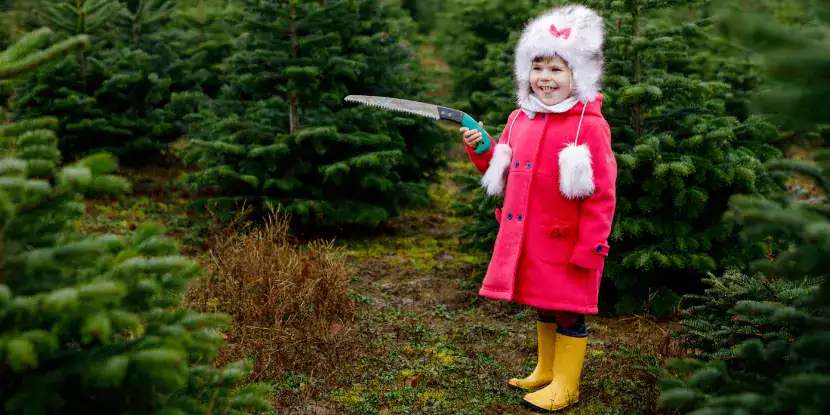
Sorry, kid. You’d do better to buy a tree from a lot.
Woo hoo! You can raise the tree in late November and still have it looking and smelling good on Christmas morning. Here’s how.
Keeping Your Cut Christmas Tree Fresh
1. Choose the Freshest Tree Possible (Duh!)
Look for:
- Flexible, green needles that stay attached when gently tugged
- A trunk that feels heavy with moisture
- Minimal needle drop when the trunk is tapped on the ground
- A fresh, woodsy scent
Avoid trees that look dull, brittle, or shed excessively.
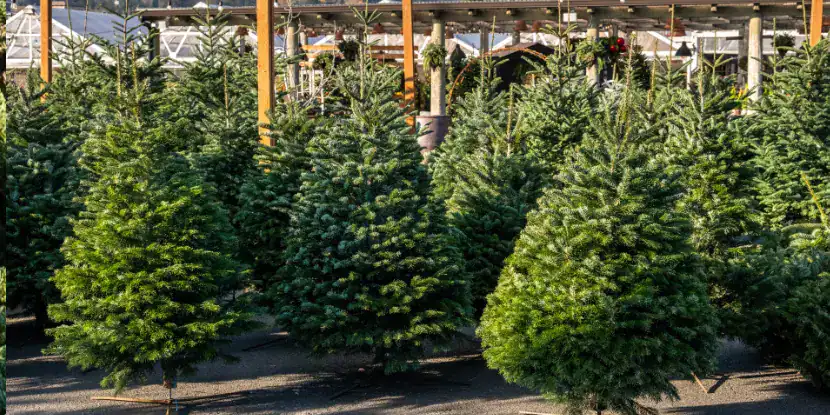
These lot trees are ready for a loving home.
2. Make a Fresh Cut Before Placing the Tree in Water
- Saw ½ to 1 inch off the base of the trunk.
- Do this within 1 hour of putting it in water. Fresh pores absorb better.
- Skip shaving the bark; this reduces the tree’s ability to drink.
3. Choose the Right Tree Stand
Look for one that:
- Holds at least 1 gallon of water
- Supports your tree’s trunk securely
- Is easy to refill without moving the tree
Rule of thumb: The stand should hold 1 quart of water per inch of trunk diameter.
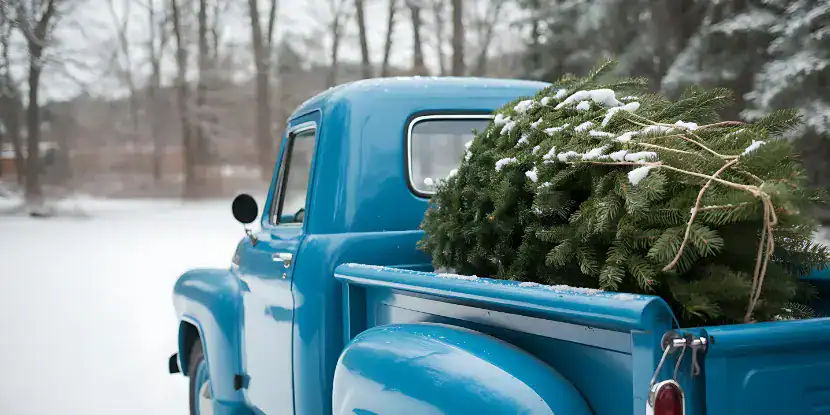
No need to trek into the wilderness when your local garden center sells perfect Christmas trees.
4. Water… Then Water Some More
- A newly cut tree can absorb 1–2 gallons in the first 24 hours.
- Afterwards, expect the tree to drink 1 quart to 1 gallon per day, depending on the species and indoor climate.
- Never let the water level fall below the freshly cut base.
5. Skip the Additives
Despite urban legends, you don’t need:
- Sugar
- Aspirin
- Bleach
- Soda
- Vodka
- Commercial “preservatives”
Plain, clean water works best.

A delivery of freshly cut Christmas trees.
6. Control Heat & Humidity
To prevent your tree from drying out:
- Keep it away from heaters, fireplaces, floor vents, and direct sunlight.
- Use LED lights that emit very little heat.
- Turn off tree lights overnight or when away from home.
- Maintain indoor humidity at a level of around 40–50%.
- Consider placing a humidifier in the room.
7. Let the Tree Breathe Outdoors if You Store It Before Decorating
- Keep your tree in a cool, shaded area.
- Stand it in a bucket of water.
- Avoid leaving it in direct sun or storing it horizontally for long periods.
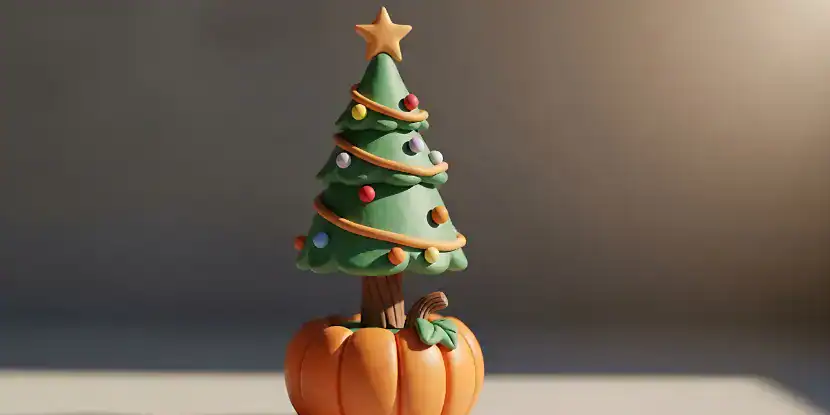
Here’s a Christmas tree that never sheds or dies. Choose this if you’re averse to tree care.
8. Rotate the Tree Occasionally
If one side faces a window or heat source, rotate the tree every few days to prevent uneven drying and maintain a uniform shape.
Fun Facts About Christmas Trees
1. Christmas trees weren’t originally part of Christmas rituals.
The modern custom originated in 16th-century Germany with the practice of decorating evergreens indoors — not initially tied to the religious holiday.

We can thank German immigrants for the tradition of the decorated Christmas tree. The Pilgrims were no fun at all.
2. The first written account of a decorated tree dates back to 1510.
A document from Riga (modern Latvia) records merchants decorating a fir tree and celebrating around it.
3. German settlers brought Christmas trees to America.
Early US Puritans banned Christmas celebrations. The tree tradition didn’t gain popularity until waves of German immigrants arrived in the 1700s and 1800s.
4. A British royal family made Christmas trees trendy.
In 1848, a sketch of Queen Victoria and Prince Albert with their Christmas tree made the practice fashionable across Britain and North America.
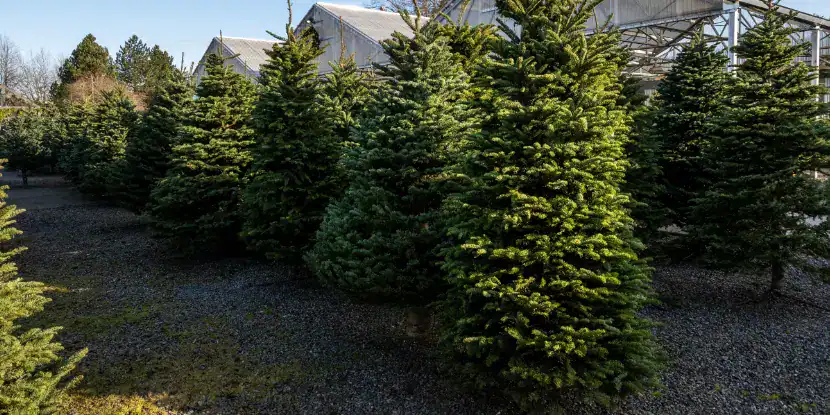
Christmas trees growing on a farm, where they’re shaped into perfectly conical conifers.
5. Fresh-cut trees are thirsty.
They can absorb up to a gallon of water in a single day.
6. Nearly all Christmas trees today are farm-grown.
Over 98% of trees come from managed farms (not forests). Most take 7–15 years to grow to holiday size.
7. Not all evergreens make good Christmas trees.
Needle-drop-prone species like spruce dry out quickly. Long-lasting favorites include:
- Fraser fir
- Noble fir
- Douglas fir
- Balsam fir
8. Trees are shaped carefully over the years.
Growers “shear” or prune trees annually to keep that perfect cone shape.
9. The fresh cut is essential.
After a few hours, sap seals the base, blocking water absorption. Cutting ½–1 inch reopens the pores.
10. The tradition has ancient roots — but not in tree form.
Ancient Egyptians, Romans, and northern Europeans used evergreens in winter festivals. But the modern cut tree tradition took shape in 16th-century Germany.
FAQs About Cut Christmas Trees
Q: How long will a cut Christmas tree last?
A cut Christmas tree will stay fresh for 3–6 weeks, depending on its species, temperature, and watering.
Q: Should I drill holes in the trunk?
No — drilling holes doesn’t help absorption. Only a fresh cut at the base matters.
Q: What if my tree stops drinking water?
- Re-cut the trunk if possible.
- Ensure it’s not near heat.
- Check for resin buildup.
- Increase the humidity in the room.
Q: Can I add sugar or fertilizer to the water?
No — tests show plain fresh water works best.
Q: Why does my tree drop needles quickly?
Possible causes:
- The tree wasn’t fresh when purchased.
- It dried out temporarily.
- The room is too warm or dry.
- The species has naturally weak needle retention (like spruce).
Q: How big should my tree stand be?
For best results, select a container with a total capacity of at least 1 gallon, and that holds 1 quart of water per inch of trunk diameter.
Q: Are certain tree species safer?
Firs (Fraser, Noble, Balsam) retain moisture well, keeping them safer and fresher longer.
Q: Can I keep a cut tree after the holidays?
Once it dries out, it becomes a fire hazard. Recycle it through a city mulching program or use branches for garden insulation.

